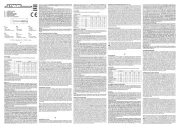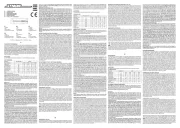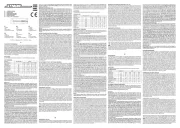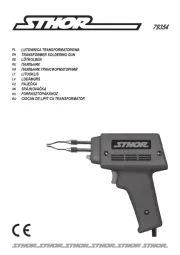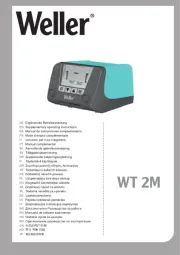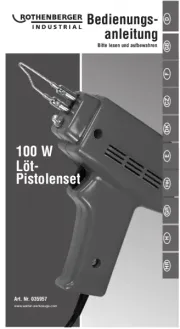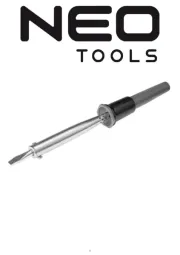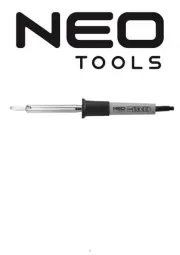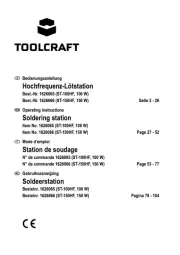
PISTOL DE LIPIT CU REZISTENŢĂ
CHARAKTERYSTYKA NARZ DZIAĘ
Lutownica przeznaczona jest do ów metalowych za pomocłączenia metodą lutowania materiał ą
spoiw cynowo - o owiowych do lutowania mi kkiego. Przyrz d zosta zaprojektowany do uł ę ą ł żytku
wyłącznie w gospodarstwach domowych i nie może być wykorzystywany profesjonalnie, tj. w
zak du ładach pracy i do prac zarobkowych. Prawidłowa, niezawodna i bezpieczna praca przyrzą
jest zale ciwej eksploatacji, dlatego: żna od wł śaPrzed przystąpieniem do pracy z narzędziem
nale .ży przeczytać całą instrukcję i zachować ją Za wszelkie szkody i obraż łenia powsta e w
wyniku u ywania narz dzia niezgodnie z przeznaczeniem, nie przestrzegania przepisów bez-ż ę
piecze ywanie ństwa i zaleceń niniejszej instrukcji dostawca nie ponosi odpowiedzialności. Uż
narzędzia niezgodnie z przeznaczeniem powoduje także utratę praw użytkownika z tytułu gwa-
rancji i niezgodno ci z umow sprzedaś ą ży.
Lutownica dostarczana jest w stanie kompletnym i nie posiada dodatkowego wyposa enia. ż
Parametr Jednostka miary Wartość
Numer katalogowy 79365 79366 79367 79368
Napi cie sieci [V] ~230 ~230 ~230 ~230ę
Cz stotliwo sieci [Hz] 50 50 50 50ę ść
Moc znamionowa [W] 30 40 60 80
Czas nagrzewania [min] 5 - 10 5 - 10 5 - 10 5 - 10
Średnica grotu [mm] 4 5 6 7
Masa [kg] 0,16 0,17 0,18 0,20
Klasa izolacji elektrycznej I I I I
OGÓLNE WARUNKI BEZPIECZE STWAŃ
UWAGA! Przeczytać ż ż ć wszystkie poni sze instrukcje. Nieprzestrzeganie ich mo e prowadzi
do pora dzie elektryczne” żenia elektrycznego, po aru albo do uszkodze cia cie „narzż ń ła. Poję ę
użyte w instrukcjach odnosi się do wszystkich narzędzi napędzanych prądem elektrycznym
zarówno przewodowych jak i bezprzewodowych.
PRZESTRZEGA PONI SZYCH INSTRUKCJIĆ Ż
Miejsce pracy nale y utrzymywa wietlone i w czystoż ć dobrze oś ści. Nieporz dek i są łabe
oświetlenie mogą być przyczynami wypadków. Nie należy pracowa narzć ędziami elektrycz-
nymi w rodowisku o zwi kszonym ryzyku wybuchu, zawieraj cym palne ciecze, gazy ś ę ą
lub opary. Narz dzia elektryczne generuj iskry, które mog spowodowa po ar w kontakcie z ę ą ą ć ż
palnymi gazami lub oparami. Nie nale y dopuszczaż ć dzieci i osób postronnych do miejsca
pracy. Utrata koncentracji mo e spowodoważ ć
utrat kontroli nad narz dziem.ę ę
Bezpiecze stwo elektryczneń
Wtyczka przewodu elektrycznego musi pasować do gniazdka sieciowego. Nie wolno
modyfi kować wtyczki. Nie wolno stosowa adnych adapterów w celu przystosowania ć ż
wtyczki do gniazdka. Niemodyfi kowana wtyczka pasuj ca do gniazdka zmniejsza ryzyko po-ą
rażenia prądem elektrycznym. Unikać kontaktu z uziemionymi powierzchniami takimi jak
rury, grzejniki i chłodziarki. Uziemienie cia a zwi ksza ryzyko pora enia pr dem elektrycz-ł ę ż ą
nym. Nie należ ż ć ęy nara a narz dzi elektrycznych na kontakt z opadami atmosferycznymi
lub wilgocią. Woda i wilgo , która dostanie si do wn trza narz dzia elektrycznego zwić ę ę ę ększa
ryzyko pora enia pr dem elektrycznym. ż ą Nie przeciąż ća kabla zasilaj cego. Nie u ka-ą ż ćywa
bla zasilaj cego do noszenia, pod czania i od czania wtyczki od gniazdka sieciowego. ą łą łą
Unikać kontaktu kabla zasilającego z ciepłem, olejami, ostrymi krawę
elementami. Uszkodzenie kabla zasilają ę ż ącego zwi ksza ryzyko pora enia pr dem elektrycz-
nym. W przypadku pracy poza pomieszczeniami zamknię ż ż ć ł żtymi nale y u ywa przed u a-
czy przeznaczonych do pracy poza pomieszczeniami zamkniętymi. Użycie odpowiedniego
przed u acza zmniejsza ryzyko pora enia pr dem elektrycznym.ł ż ż ą
Przystępuj do pracy w dobrej kondycji fi zycznej i psychicznej. Zwracaj uwag na to, co ę
robisz. Nie pracuj b c zmę ądęczonym lub pod wp ywem leków lub alkoholu.ł Nawet chwila
nieuwagi podczas pracy mo e prowadzi do powa nych obraż ć ż żeń ł cia a. Uż śywaj rodków ochro-
ny osobistej. Zawsze zak adaj gogle ochronne.ł Stosowanie rodków ochrony osobistej, takich ś
jak maski przeciwpy owe, obuwie ochronne, kaski i ochronniki s uchu zmniejszaj ryzyko pował ł ą ż-
nych obra ciaż ńeła. Unikaj przypadkowego w
łą łączenia narzędzia. Upewnij się, że w cznik
elektryczny jest w pozycji „wy czony” przed pod czeniem narz dzia do sieci elektro-łą łą ę
energetycznej. Trzymanie narzędzia z palcem na włą łączniku lub pod czanie narzędzia elek-
trycznego, gdy w cznik jest w pozycji „w czony” mo e prowadzi do powa nych obrałą łą ż ć ż żeń ł cia a.
Przed w czeniem narz dzia elektrycznego usu wszelkie klucze i inne narz dzia, które łą ę ń ę
zostały użyte do jego regulacji. Klucz pozostawiony na obracających się elementach narzędzia
może prowadzić do poważnych obrażeń ł cia a. Utrzymuj równowag . Przez caę ły czas utrzymuj
odpowiednią postawę. Pozwoli to na łatwiejsze zapanowanie nad narz dziem elektrycznym w ę
przypadku niespodziewanych sytuacji podczas pracy. Stosuj odzie ochronn . Nie zakż ą ładaj
luźniej odzieży i biżuterii. Utrzymuj włosy, odzie i r kawice robocze z dala od ruchomych ż ę
części narzędzia elektrycznego. Luźna odzież, biżuteria lub d ugie w osy mog zaczepi o ru-ł ł ą ć
chome cz ci narzęś ędzia. Stosuj odci gi py u lub pojemniki na py , jeą ł ł śli narz dzie jest w takie ę
wyposa czyżone. Zadbaj o to, aby je poprawnie podłą ć. Użycie odciągu pyłu zmniejsza ryzyko
powa nych obraż ż ńe cia a. ł
U ytkowanie narz dzia elektrycznegoż ę
Nie przeci aj narz dzia elektrycznego. U ywaj narz dzia wąż ę ż ę łaściwego do danej pracy. Od-
powiedni dobór narzędzia do danej pracy, zapewni wydajniejsz i bezpieczniejsz pracą ą ę. Nie
używaj narzędzia elektrycznego, jeśli nie dzia a jego w cznik sieciowy.ł łą Narz dzie, które nie ę
daje si kontrolowa za pomocę ć ą włącznika sieciowego jest niebezpieczne i należy je oddać do
naprawy. Odłącz wtyczkę od gniazdka zasilającego przed regulacją, wymianą akcesoriów
lub przechowywaniem narzędzia. Pozwoli to na unikni cie przypadkowego w czenia narzę łą ę-
dzia elektrycznego. Przechowuj narz dzie w miejscu niedost pnym dla dzieci. Nie pozwól ę ę
pracowa dzia.ć osobom nieprzeszkolonym w zakresie obsługi narzę Narzędzie elektryczne
mo ugi. że być niebezpieczne w rękach nieprzeszkolonej obsłZapewni wła ściwą konserwację
narzędzia. Sprawdzaj narzędzie pod kątem niedopasowań i luzów ruchomych części.
Sprawdzaj czy jakikolwiek element narz dzia nie jest uszkodzony. W przypadku wykrycia ę
usterek nale y je naprawiż ć
przed u yciem narz dzia elektrycznego.ż ę Wiele wypadków jest
spowodowanych przez niew ciwe konserwowane narzł śaędzia. Narzędzia tnące należy utrzy-
mywać czyste i naostrzone. Wł śa ciwie konserwowane narz dzia tn ce jest atwiej kontrolowaę ą ł ć
podczas pracy. Stosuj narz szymi instrukcja-ędzia elektryczne i akcesoria zgodnie z powyż
mi. Stosuj narz c pod uwag rodzaj i warunki pracy.ędzia zgodnie z przeznaczeniem biorą ę
Stosowanie narz dzi do innej pracy ni zosta y zaprojektowane mo e zwię ż ł ż ększyć ryzyko powsta-
wania niebezpiecznych sytuacji.
Naprawiaj narz dzie tylko w uprawnionych do tego zak adach, u cych tylko ory-ę ł ż ąywaj
ginalnych części zamiennych. Zapewni to wł śa ciwe bezpiecze stwo pracy narz dzia elek-ń ę
INSTRUKCJE BEZPIECZE STWA U YTKOWANIAŃ Ż
Lutownice wolno pod tylko do sieci elektroenergetycznej o parametrach 230V/50Hz. łą ćcza
Aby unikn aru i poparzeąć poż ń
nale y zawsze stosowa specjalne, niepalne podstawki pod ż ć
lutownicę. Po nagrzaniu lutownicę wolno trzymać tylko za uchwyt. Dotknięcie grotu lub innych
metalowych części nagrzanej lutownicy grozi poparzeniami. Nie wolno dopuś ćci do jakiegokol-
wiek kontaktu kabla zasilaj cego z nagrzanymi cz ciami metalowymi. Grozi to poraą ęś żeniem
elektrycznym. W przypadku uszkodzenia kabla, należy od lutownic od sieci zasilajłą ćczy ę ącej.
Zabrania si pracy lutownic cym. Uszkodzony kabel naleę ą z uszkodzonym kablem zasilają ży
wymienić w uprawnionym do tego zakładzie naprawczym. Nie wolno naprawiać uszkodzo-
nych przewodów elektrycznych narzędzia. Po pracy nale dzie na podstaw-ży od narzł ż ćo y ę
kę i pozwolić ostygnąć lutownicy. Jest to jedyny dopuszczalny sposób ch odzenia narzł ędzia.
Nie nale c j do wody, mo e to spowodowa pora enie prży studzi lutownicy wkć ł ąadaj ą ż ć ż ądem
ą ć żdzenie nie powinno by u ytkowane przez dzieci lub osoby o ograniczonej
sprawno ci śfi zycznej, czuciowej i psychicznej lub przez osoby bez do wiadczenia i wiedzy, ś
chyba że zostają pod nadzorem lub zostały przeszkolone. Należy nadzorować dzieci, aby nie
potraktowały urządzenia jako zabawkę. Grot lutownicy wymieniać tylko przy wyłączonym zasi-
laniu. Wtyczk przewodu zasilaj y wyję ącego należ ąc z gniazda sieci elektroenergetycznej. Przed
wymian , adaą grotu upewnić się że lutownica ostygła. Grot wkł ć aż do wyczucia oporu. Mocno
i pewnie przykrę ćci grot do uchwytu. Nie wolno nagrzewać lutownicy bez zamontowanego gro-
tu. Brak grotu podczas nagrzewania mo ycie si elementu że spowodować przedwczesne zuż ę
grzejnego lutownicy. Przed rozpoczęciem nagrzewania nale y si upewni e grot jest mocno ż ę ć ż,
i pewnie dokręcony do gniazda lutownicy. Zawsze nale element grzejny i grot ży utrzymywać
lutownicy w czysto dotykania rozgrzanym grotem izolacji przewodów elektrycz-ści. Zabrania się
ę ż ż ś u ywania lutownicy w warunkach podwy szonej wilgotno ci oraz w atmos-
ferze gazów oraz py cych. Nie wolno lutowa elementów znajdujłów wybuchowych i ż ąrć ących
PRZYGOTOWANIE DO PRACY I U YTKOWANIE NARZ DZIAŻ Ę
Przed rozpocz y sprawdzi , czy korpus obudowy oraz przewód przyęciem pracy należ ć łącze-
niowy z wtyczk i zewn trzne przewody przed ce nie s uszkodzone. W razie potrzeby ą ę ł ż ąu aj ą
nale ci niży oczyś ć narzędzie z zanieczyszczeń i udroż ć otwory wentylacyjne. W przypadku
stwierdzenia uszkodze ci zwiń zabrania si dalszej pracy! ęUwaga! Wszystkie czynnoś ązane
z wymian y przeprowadza czonym napią grota, czyszczeniem itp. należ ć przy wyłą ęciu zasila-
j ci: ącym narzędzie, dlatego przed przystąpieniem do tych czynnośWyci gną ąć
wodu narzędzia z gniazda sieciowego! Lutowanie powinna wykonywać osoba dorosła za-
poznana z przepisami bezpiecze stwa i higieny pracy przy pracach zwi zanych z lutowaniem. ń ą
Przed u dzia należyciem narzę ży upewnić si , czy parametry sieci elektrycznej s zgodne z da-ę ą
nymi umieszczonymi na tabliczce znamionowej. Przed lutowaniem należy dok adnie oczył ś ćci
łą żczone elementy metalowe, a tak e grot lutownicy. W przypadku przepalenia się grota należy
wymienić go na nowy. Przed lutowaniem, nale ży oczy lutowane powierzchnie ze wszel-ś ćci
kich zanieczyszczeń, zw aszcza t lutownic o mocy odpowiadaj cej rodzajowi ł ł ćuszczu.Wybra ę ą
wykonywanej pracy. Moc 20 - 30W: lutowanie elementów na p ytkach scalonych, lutowanie ł
elementów elektronicznych ma ych rozmiarów. Moc 40 - 60W: Lutowanie elementów elektro-ł
nicznych i elektrycznych (np. w czniki, styki). Moc 80 - 100W: Je li do lutowania elementów łą ś
jest potrzebna większa moc. Upewnić się, ż źe grot jest czysty oraz pewnie zamocowany w gnie -
dzie lutownicy. Ustawić lutownic na podstawce, a nast pnie podę ę łączy
ć ą ja do sieci zasilaj cej.
Poczeka ywajć, aż grot osiągnie wymaganą temperaturę. Rozpocząć lutowanie uż ąc topnika i
spoiwa (cyny lutowniczej). Grot przyk tylko do miejsc, które majł ćada ą by po czone. Spoiwo ć łą
powinno sp z grotu do spoiny, gdy ta osi gnie w temperatur . Po sko czonej pracy ł ąćyn ą ł ś ąa ciw ę ń
oraz w chwilach, gdy narz dzie nie jest u ywane nale y je umieszcza na podstawce.ę ż ż ć
UWAGA! Przed przyst ugi technicznej lub konserwacji wyciąpieniem do regulacji, obsł ągnij
wtyczk ę narzędzia z gniazdka sieci elektrycznej. Po zakończonej pracy należy sprawdzić
stan techniczny elektronarzędzia poprzez ogl dziny zewn trzne i ocen : korpusu i rę ę ę ę śkoje ci,
przewodu elektrycznego z wtyczką i odgi , dzia ania wę ątk ł
łą ż ścznika elektrycznego, dro no ci
szczelin wentylacyjnych, iskrzenia szczotek, g ysk i przekł ś śo no ci pracy ł żoładni, rozruchu i
równomierności pracy. W okresie gwarancji u ytkownik nie mo e domontowa elektronarzż ż ć ędzi,
ani wymienia adnych podzespo ci sk powoduje to utrat praw ć ż łów lub częś ładowych, gdyż ę
gwarancyjnych. Wszelkie nieprawid ci obserwowane przy przeglł śowo ądzie, lub w czasie pra-
cy, s sygna em do przeprowadzenia naprawy w punkcie serwisowym. Po zako czeniu pracy, ą ł ń
obudow koje ci ę, szczeliny wentylacyjne, przełączniki, rę ść dodatkową i osłony należy oczyś ć
np. strumieniem powietrza (o ci nieniu nie wi 0,3 MPa), p dzlem lub suchś ększym niż ę ą szmatką
bez u rodków chemicznych i p ynów czyszcz cych. Narzż śycia ł ą ę
dzia i uchwyty oczy suchś ćci ą
Ten symbol informuje o zakazie umieszczania zu ytego sprz tu elektrycznego i elektronicznego ż ę
(w tym baterii i akumulatorów) cznie z innymi odpadami. Zu yty sprz t powinien byłą ż ę ć zbierany
selektywnie i przekazany do punktu zbierania w celu zapewnienia jego recyklingu i odzysku,
aby ogranicza odpadów oraz zmniejszy wykorzystania zasobów naturalnych. ć ilość ć stopnień
Niekontrolowane uwalnianie składników niebezpiecznych zawartych w sprz cie elektrycznym i elek-ę
tronicznym mo enie dla zdrowia ludzkiego oraz powodowa negatywne zmiany w że stanowić zagroż ć
ś ł ż ą ę ęrodowisku naturalnym. Gospodarstwo domowe pe ni wa n rol w przyczynianiu si do ponownego
u ażycia i odzysku, w tym recyklingu zużytego sprzętu. Więcej informacji o wł ściwych metodach recy-
klingu mo na uzyska u w adz lokalnych lub sprzedawcy.ż ć ł
von persönlichen Schutzmitteln wie Staubmasken, Schutzschuhe, Helme und Gehörschutz ver-
mindern die Gefahr der ernsthaften Körperverletzungen. Das zufällige Einschalten des Elekt-
rowerkzeuges vermeiden. Bitte prüfen ob der Schalter in der Stellung „AUS” steht bevor
das Elektrowerkzeug an das elektrische Netz angeschlossen wird. Das Halten der Finger
auf dem Schalter oder Anschluss des Elektrowerkzeuges bei dem eingeschalteten Schalter
kann zu ernsthaften Körperverletzungen führen. Vor Einschalten des Elektrowerkzeuges
sollen alle Schlüssel und Werkzeuge entfernt werden, die zur Einstellung verwendet
worden waren. Der an den beweglichen Teilen des Werkzeuges hintergelassene Schlüssel
kann ernsthafte Körperverletzungen herbeiführen. Gleichgewicht halten. Durch die ganze
Zeit entsprechende Arbeitsstellung einnehmen. Dadurch lässt sich das Elektrowerkzeug in
den unerwarteten Notfällen bei der Arbeit leichter beherrschen. Schutzkleidung tragen. Keine
lose Kleidung oder Schmuck tragen. Haare, Kleidung und Arbeitshandschuhe fern von
den beweglichen Teilen des Elektrowerkzeuges halten. Lose Kleidung, Schmuck oder lange
Haare können an die bewegliche Teile des Elektrowerkzeuges anhaken. Staubabsaugung
oder Staubbehälter verwenden falls das Werkzeug damit ausgestattet wird. Bitte sorgen
Sie dafür damit sie sachgemäß angeschlossen sind. Verwendung der Staubabsaugung ver-
mindert die Gefahr der ernsthaften Körperverletzungen.
Verwendung des Elektrowerkzeuges
Das Elektrowerkzeug nicht überlasten. Das zur ausführende Aufgabe geeignete Werk-
zeug verwenden. Entsprechende Auswahl des Werkzeuges gewährleistet eine leistungsfähi-
ge und sichere Arbeit. Das Werkzeug darf nicht verwendet werden, falls der Netzschalter
nicht funktioniert. Das Werkzug, welches sich mit dem Schalter nicht kontrollieren lässt, ist
gefährlich und soll zur Reparatur geliefert werden. Den Leitungsstecker von der Netzsteck-
dose herausziehen wenn das Werkzeug eingestellt oder Zubehör ausgetauscht bzw. das
Werkzeug aufbewahrt wird. Dadurch wird das zufällige Einschalten des Elektrowerkzeuges
vermieden. Das Elektrowerkzeug vor den Zutritt von Kindern schützen. Die bei der Be-
dienung des Werkzeuges nicht eingeschulten Personen dürfen das Werkzeug nicht ver-
wenden. Das Elektrowerkzeug kann in den Händen der nicht geschulten Personen gefährlich
sein. Entsprechende Instandhaltung des Werkzeuges gewährleisten. Das Werkzeug auf
nicht eingepasste Teile und Spiele der beweglichen Teile prüfen. Bitte überprüfen, ob
irgendein Bestandteil des Werkzeuges nicht beschädigt ist. Die Störungen sollen vor
dem Einsatz des Werkzeugen beseitigt werden. Viele Unfälle sind durch nicht sachgemäße
Instandhaltung des Werkzeuges verursacht. Schneidewerkzeugen sollten sauber und ge-
schärft sein. Sachgemäß geschärfte Schneidenwerkzeuge lassen sich besser während der
Arbeit kontrollieren. Dei Elektrowerkzeuge und Zubehör gemäß der vorstehenden Anwei-
sungen benutzen. Die Werkzeuge entsprechend der Aufgabe und die Arbeitsbedingun-
gen einsetzen. Die nicht bestimmungsgemäße Verwendung des Werkzeuges kann das Risiko
Die Werkzeuge sollen nur in den autorisierten Werkstätten bei der Verwendung der
Originalersatzteile repariert werden. Dadurch wird die entsprechende Arbeitssicherheit des
Elektrowerkzeuges gewährleistet .
Der Lötkolben darf nur an das Netz 230V / 50 Hz angeschlossen werden. Um einen Brand
und Verbrennung zu vermeiden, spezielle, nicht brennbare Untersätze unter den Lötkolben
immer verwenden. Lötkolben nach dem Aufheizen nur am Griff halten. Berühren der Lötspitze
oder anderen Metallteile droht mit der Verbrennung. Keinen Kontakt des Netzkabels mit heißen
metallischen Teilen zulassen, weil es mit dem Stromschlag droht. Falls das Kabel beschädigt
ist, Lötkolben vom Netz trennen. Es ist verboten, den Lötkolben mit beschädigtem Netzkabel
zu benutzen. Beschädigtes Kabel in der berechtigten Werkstätte wechseln. Es ist verboten,
beschädigte Leitungen zu reparieren. Lötkolben nach der Arbeit auf den Untersatz ablegen
und abkühlen lassen. Das ist eine einzige zulässige Methode, den Lötkolben abzukühlen. Löt-
kolben nicht im Wasser abkühlen, das kann zum Stromschlag führen. Lötspitze nur bei der
abgeschalteten Speisung wechseln. Stecker aus der Steckdose abziehen. Vor dem Lötspitzen-
wechseln vergewissern Sie sich, dass der Lötkolben abgekühlt ist. Lötspitze bis zum spürbaren
Widerstand einschieben, dann stark und zuverlässig im Halter befestigen. Lötkolben nicht ohne
Lötspitze aufheizen. Aufheizen ohne Spitze führt zur vorzeitigen Abnutzung des Heizelementes.
Vor dem Aufheizen des Lötkolbens vergewissern Sie sich, dass die Lötspitze fest und zuver-
lässig im Halter befestigt ist. Heizelement und Lötspitze immer rein halten. Es ist verboten,
Kabelisolation mit der heißen Lötspitze zu berühren. Es ist verboten, Lötkolben bei der erhöhten
Feuchtigkeit, wie auch in der Atmosphäre von explosiven und ätzenden Gasen und Stauben zu
benutzen. Es ist verboten, Elemente unter der Spannung zu löten!
VORBEREITUNG ZUR ARBEIT, GEBRAUCH
Vor dem Arbeitsbeginn prüfen, ob das Gehäuse und Anschlusskabel, wie auch Verlängerungs-
kabel nicht beschädigt sind. Falls notwendig, Lötkolben reinigen, Luftlöcher saubern. Es ist ver-
boten, Arbeit mit beschädigtem Lötkolben fortzusetzen! Alle mit dem Spitzenwechsel, Achtung!
mit der Reinigung usw. verbundenen Tätigkeiten nur bei abgetrennter Spannung durchführen,
deshalb vor dem Beginn Löten soll eine erwachsene, Stecker aus der Steckdose abziehen!
mit den Unfallverhütungsvorschriften beim Löten vertraut gemachte Person durchführen. Vor
dem Gebrauchen des Werkzeuges vergewissern Sie sich, dass die Netzparameter mit den
Daten auf dem Typenschild übereinstimmen. Die zu verbindenden metallischen Elemente, wie
auch die Lötspitze vor dem Löten genau reinigen. Falls die Lötspitze durchgebrannt ist, zur
neuen tauschen. Die zu verbindenden Oberfl ächen besonders vom Fett genau reinigen. Löt-
kolben mit der der auszuführenden Arbeit entsprechenden Leistung wählen: 20 - 30 W: Löten
von Elementen auf den Druckplatinen, von kleinen elektronischen Teilen; 40 - 60 W: Löten
von elektrischen und elektronischen Teilen, wie Schalter, Kontakte; 80 - 100 W: Löten, wenn
größere Leistung notwendig ist. Vergewissern Sie sich, dass die Lötspitze sauber ist und im
Halter fest sitzt. Lötkolben auf den Untersatz stellen, an das Netz anschließen. Abwarten, bis
die Lötspitze eine erforderliche Temperatur erreicht. Löten mit dem Lötfl ussmittel und mit der
Lötlegierung (Lötzinn) beginnen. Lötspitze nur an die zu verbindenden Stellen anlegen. Die
Lötlegierung soll von der Lötspitze in die Naht fl ießen, wenn sie eine erforderliche Temperatur
erreicht. Lötkolben nach der Arbeit und wenn er nicht gebraucht wird auf den Untersatz ab-
legen. Abgenutzte elektrische und elektronische Geräte dürfen nicht mit anderen Abfällen zu-
sammen gesammelt werden. Abgenutzte Geräte dem Verkäufer übergeben oder in die nächste
Recyclingsstelle entsorgen.
KONSERVIERUNG UND ÜBERSICHTUNGEN
ACHTUNG! Vor dem Beitritt zur Regulierung, technischen Bedienung und Konservierung soll
man die Einrichtung von der Elektronetz durch die Herausziehung des Steckers aus der Netz-
dose abschalten. Nach der Beendung der Arbeit soll man technischen Stand durch äußere Be-
sichtigungen und die Beurteilung von: Gestell und Handgriff , Elektroleitung mit Stecker und Ab-
biegungsstück, Tätigkeit des Elektroschalters, Durchgängigkeit von Lüftungsschlitzen, Funken
von Bürsten, Arbeitslautstärke von Lager und Getriebe, Anfahren und Arbeitsgleichmäßigkeit
überprüfen. In der Garantiezeit kann der Benutzer keine Elektrowerkzeuge demontieren oder
keine Bauteile sowie Bestandteile austauschen, weil dies eine Verlierung der Garantierechte
verursacht. Alle beobachtete bei der Übersicht oder in der Arbeitszeit Unrichtigkeiten bestim-
men das Signal zur Durchführung der Reparatur im Service. Nach der Beendung der Arbeit
soll man Gehäuse, Lüftungsschlitze, Schalter, Zusatzhandgriff und Bedeckungen z.B. mit dem
Druckluftstrahl (vom Druck nicht größer als von 0,3 MPa), Pinsel oder trockenen Lappen ohne
Benutzung von Chemiemittel und Reinigungsfl üssigkeiten reinigen. Die Werkzeuge und Hand-
griff e soll man mit dem sauberen, trockenen Lappen reinigen.
4. przewód sieciowy z wtyczką
3. нагревательный элемент
4. сетевой провод с вилкой
4. cablu electric cu tec rş ă
4. napájecí kabel se zástr kouč
operation of the tool depends on its proper use, so: Before you proceed to work with the tool,
read the whole manual and keep it. The supplier will not be held responsible for any damage
and injuries caused by operating the tool contrary to its intended purpose, failure to observe
safety regulations and the indications mentioned in this manual. Operation of the tool contrary
to its intended use implies also cancellation of the user’s guarantee and contractual rights.
The soldering tool is delivered complete and has no additional accessories.
Parameter Measurement unit Value
Catalogue number 79365 79366 79367 79368
Rated voltage [V] ~230 ~230 ~230 ~230
Rated frequency [Hz] 50 50 50 50
Rated power [W] 30 40 60 80
Heating time [min] 5 - 10 5 - 10 5 - 10 5 - 10
Tip diameter [mm] 4 5 6 7
Weight [kg] 0,16 0,17 0,18 0,20
GENERAL SAFETY CONDITIONS
NOTE! Get acquainted with all the instructions below. Failure to observe them may lead to an
electric shock, fi re or injuries. The notion of electric tool used in the instructions applies to all the
tools which are powered with electric current, both wire tools and wireless ones.
OBSERVE THE FOLLOWING INSTRUCTIONS
The place of work must be properly illuminated and clean. Disorder and poor illumination
may be a cause of accidents. Do not work with electric tools in explosive environments, or
those which contain infl ammable liquids, gases or vapours. Electric tools generate sparks,
which may cause a fi re in case of contact with infl ammable gases or vapours. Do not allow
children and outsiders to the place of work. A lack of concentration may result in a loss of
The plug of the power supply cable must fi t the mains socket. Do not modify the plug.
Do not use any adapters whatsoever in order to adapt the plug to the socket. Unmodifi ed
plug which fi ts the socket reduces the risk of an electric shock. Avoid contact with grounded
surfaces, such as pipes, heaters and refrigerators. Grounding of the body increases the
risk of an electric shock. Do not expose electric tools to precipitation or humidity. Water
and humidity which gets into the electric tool increases the risk of an electric shock. Do not
overload the power supply cable. Do not use the power supply cable in order to carry
the tool or to connect and disconnect the plug from the mains socket. Avoid contact of
the power supply cable with heat, oils, sharp tools and moving elements. Damage to the
power supply cable increases the risk of an electric shock. In case work is realised outside
closed areas, it is necessary to use extension cords designed for applications outside
closed areas. Using a correct extension cord permits to reduce the risk of an electric shock.
Commence work in good physical and psychological conditions. Pay attention to what
you do. Do not work if you are tired or under eff ects of medicines or alcohol. Even a mo-
ment’s inattention during work may lead to serious injuries. Always use individual means of
protection. Always wear goggles. Using individual means of protection, such as dust-masks,
protective shoes, helmets and hearing protections permits to reduce the risk of serious injuries.
Avoid accidental activation of the tool. Make sure the switch is in the OFF position, befo-
re you connect the tool to the mains. Holding the tool with a fi nger on the switch or connecting
an electric tool when the switch is in the ON position may lead to serious injuries. Before you
turn an electric tool on remove all the spanners and other tools, which have been used
for adjustments. A spanner left on rotating elements of the tool may lead to serious injuries.
Keep your balance. Maintain an appropriate position. It will permit to control the electric
tool in case of unpredicted situations during its operation. Use protective clothes. Do not
wear loose clothes or jewellery. Keep your hair, clothes and gloves away from moving
elements of the electric tool. Loose clothes, jewellery or long hair may get caught on moving
elements of the tool. Use dust extractors or dust containers, if the tool is equipped with
any. Make sure they are properly connected. Using of dust extractors permits to reduce the
risk of serious injuries.
Operation of the electric tool
Do not overload the electric tool. Use a proper tool for the given purpose. A correct selec-
tion of the tool for the given work will result in a more effi cient and safer work. Do not use the
electric tool if the switch is not functioning properly. A tool which may not be controlled by
means of a switch is dangerous and must be repaired. Disconnect the plug from the mains
socket before any adjustment, replacement of accessories or storage of the tool. It will
permit to avoid accidental activation of the electric tool. Store the tool away from children. Do
not allow untrained persons to operate the tool. An electric tool may be dangerous in hands
of an untrained person. Make sure the tool is properly maintained. Check the tool in order
to detects any unfi tting or loose moving elements. Check whether the elements of the
tool are not damaged. In case any damaged elements of the tool are detected, they must
be repaired before the electric tool is operated. Many accidents are caused by improper ma-
intenance of tools. Properly maintained cutting tools Cutting tools must be sharp and clean.
are easier to control during work. Use electric tools and accessories in accordance with
the aforementioned instructions. Use the tool in accordance with its purpose, taking into
account the kind and conditions of work. Should the tool be used for other applications than
the ones it has been designed for, the risk of a dangerous situation increases.
The tool may be repaired only by authorised service centres, which must use solely
original spare parts. It will guarantee a proper level of safety of operation of the electric tool.
USER’S SAFETY INSTRUCTIONS
The soldering tool must be connected to a 230V/50Hz mains. In order to avoid fi re and burns,
it is required to use special non-infl ammable supports for the soldering tool at all times. Once
the soldering tool has reached its working temperature, it must be held by the handle. Touching
the soldering tip or other metal elements of the hot part of the soldering tool may lead to burns.
Avoid any contact of the power supply cord with hot metal elements. This may lead to electric
shock. If the cord is damaged, the soldering tool must be disconnected from the mains. It is
prohibited to work with a soldering tool with a damaged power supply cord. Have the damaged
cord replaced in an authorised workshop. It is prohibited to repair damaged electric cables
of the tool. Once work has concluded, place the tool on the support and wait until the soldering
tool has cooled down. This is the only acceptable manner of cooling the tool down. Do not cool
the soldering tool immersing it in water, which may lead to electric shock. The tool should not be
used by children or persons of limited physical, sensorial or psychical capacities, or by persons
who do not have suffi cient experience or knowledge, unless they are supervised or have been
trained. Supervise children and do not permit them to play with the tool. The tip of the soldering
tool may be replaced only with the power supply off . Remove the plug of the power supply cord
from the mains socket. Before replacement of the soldering tip make sure the soldering tool is
cold. Insert the soldering tip until you feel resistance. Turn the soldering tip onto the holder in
a secure and tight manner. Do not heat the soldering tool if a soldering tip is not installed. A
lack of a soldering tip during heating may reduce the life of the heating element of the soldering
tool. Before you start heating the tool, make sure the soldering tip is tightly fi xed in the socket
of the soldering tool. Always keep the heating element and the tip of the soldering tool clean. It
is prohibited to touch insulation of electric conductors with a hot soldering tip. It is prohibited to
use the soldering tool in high humidity conditions or in an atmosphere of explosive and caustic
gases or powders. Soldering of live elements is prohibited!
PREPARATION FOR WORK AND OPERATION OF THE TOOL
Before work make sure the body of the tool, the electric cord with plug and external extension
cords are not damaged. If necessary clean the tool and the ventilation orifi ces. In case any dam-
age is detected, it is prohibited to continue work! Attention! All actions related to replacement
of the soldering tip, cleaning, etc. must be realised with the power of the tool disconnected, so
before you proceed to carry out such actions: Remove the plug of the cord of the tool from
the mains socket! Soldering must be realised by a person who is familiar with the safety regu-
lations for soldering. Before the tool is used, make sure the parameters of the mains comply with
the values indicated in the rating plate. Before soldering, clean thoroughly the metal elements
to be soldered, as well as the tip of the soldering tool. In case the soldering tip is burnt, it must
be replaced with a new one. Before soldering, clean the surfaces to be soldered, particularly of
any grease. Select a soldering tool whose power is adequate for the kind of work to be carried
out. 20-30W: soldering of elements on integrated circuit boards, soldering of small electronic
elements. 40-60W: soldering of electronic and electric elements (e.g. switches, contacts). 80-
100W: if higher power is required for soldering of elements. Make sure the soldering tip is clean
and tightly fi xed in the socket of the soldering tool. Place the soldering tool on the support, and
then connect it to the mains. Wait until the soldering tip has reached the required temperature.
Start soldering using solder fl ux and solder (soldering tin). Put the soldering tip in places to
be bound. The solder should fl ow from the soldering tip to the weld, when it has reached the
adequate temperature. Once work has been concluded and when the tool is not used, it must
be placed on the support.
ATTENTION! Before any adjustment, technical service or maintenance operations unplug the
tool. Once the operations have been fi nished, the technical conditions of the tool must be as-
sessed by means of external evaluation and inspection of the following elements: body and
handle, conductor with a plug and defl ection, functioning of the electric switch, patency of ven-
tilation slots, sparking of brushes, noise level of functioning of bearings and gears, start-up and
smoothness of operation. During the guarantee period, the user cannot dismantle the electric
tools or change any sub-assemblies or elements, since it will cancel any guarantee rights. All
irregularities detected at overhaul or during functioning of the tools are a signal to have the tool
repaired at a service shop. Once the functioning has been concluded, the casing, ventilation
slots, switches, additional handle and protections must be cleansed with a stream of air (at a
pressure not exceeding 0.3 MPa), with a brush or a cloth without any chemical substances or
cleaning liquids. Tools and handles must be cleansed with a clean cloth.
This symbol indicates that waste electrical and electronic equipment (including batteries and
storage cells) cannot be disposed of with other types of waste. Waste equipment should be
collected and handed over separately to a collection point for recycling and recovery, in order
to reduce the amount of waste and the use of natural resources. Uncontrolled release of hazar-
dous components contained in electrical and electronic equipment may pose a risk to human health
and have adverse eff ects for the environment. The household plays an important role in contributing to
reuse and recovery, including recycling of waste equipment. For more information about the appropriate
recycling methods, contact your local authority or retailer.
TOYA S.A. ul. So tysowicka 13-15, 51-168 Wroc aw, Polskał ł
Der Lötkolben ist zum Löten der Metalle mit den Zinn-Blei-Lötlegierungen zum Weichlöten be-
stimmt. Der Lötkolben ist zum Gebrauch im Haushalt ausgelegt und darf nicht zu den profes-
sionellen Zwecken (d.h. in den Werken und zu den gewerblichen Zwecken) eingesetzt werden.
Eine Richtige, zuverlässige und sichere Funktion hängt vom richtigen Gebrauch, deshalb ist es
empfohlen, vor dem Arbeitsbeginn die ganze Betriebsanweisung genau zu lesen und sie
aufzubewahren. Für allerartige Schäden und Verletzungen infolge des nicht bestimmungs-
mässigen Gebrauchs und Nichtbeachtens der Unfallverhütungsvorschriften, wie auch der vor-
liegenden Betriebsanweisung trägt der Lieferant keine Verantwortung. Der nicht bestimmungs-
mässige Gebrauch zieht nach sich auch eine Verlust von Garantierechten.
Der Lötkolben wird im kompletten Zustand geliefert und hat keine zusätzliche Ausrüstung.
Katalognummer 79365 79366 79367 79368
Netzspannung [V] ~230 ~230 ~230 ~230
Netzfrequenz [Hz] 50 50 50 50
Nennleistung [W] 30 40 60 80
Aufheizungszeit [min] 5 - 10 5 - 10 5 - 10 5 - 10
Temperatur der Lötspitze [
Lötspitzendurchmesser [mm] 4 5 6 7
Gewicht [kg] 0,16 0,17 0,18 0,20
ALLGEMEINE SICHERHEITSBEDINGUNGEN
ACHTUNG! Die nachstehenden Anweisungen durchlesen. Die Nichteinhaltung der nachste-
henden Anweisungen kann einen elektrischen Schlag, Brand oder Körperverletzungen führen.
Der Begriff „Elektrowerkzeug” bezieht sich auf alle mit dem elektrischen Strom angetriebenen
Werkzeuge sowohl mit der Netzleitung als auch ohne Netzleitung.
DIE NACHSTEHENDEN ANWEISUNGEN EINHALTEN!
Der Arbeitsplatz soll gut beleuchtet sein und In der Sauberkeit gehalten werden. Das
Durcheinander und nicht ausreichende Beleuchtung können Arbeitsunfälle verursachen. Die
Elektrowerkzeuge dürfen in der Umgebung mit erhöhter Explosionsgefahr, oder brenn-
baren Flüssigkeiten Gasen oder Dunste nicht verwendet werden. Die Elektrowerkzeuge
erzeugen Funken, die in Berührung mit brennbaren Gasen oder Dunsten Brand verursachen
können. Kindern und unbefugte Personen fern von dem Arbeitsplatz halten. Die Konzent-
rationsschwäche kann zum Verlieren des Beherrschens über dem Werkzeug führen.
Leitungsstecker muss an die Netzsteckdose passen. Der Stecker darf nicht modifi ziert
werden. Keine Adapter zur Anpassung des Leitungssteckers an die Netzsteckdose ver-
wenden. Der nicht modifi zierte Leitungsstecker, der genau an die Netzsteckdose passt ver-
mindert die Gefahr des elektrischen Schlages. Den Kontakt mit geerdeten Flächen wie
Rohre, Heizkörper, Kühlschränke vermeiden. Die Körpererdung erhöht das Risiko des
elektrischen Schlages. Die Elektrowerkzeuge dürfen dem Einfl uss von atmosphärischen
Niederschlägen oder Der Feuchtigkeit nicht ausgesetzt werden. Wasser und Feuchtig-
keit, die in das Innere des Elektrowerkzeuges eindringen, erhöhen die Gefahr des elektrischen
Schlages. Den Netzkabel nicht überlasten. Die Netzkabel nicht zum Tragen, Abschalten
und Einschalten des Leitungssteckers zum Netzsteckdose verwenden. Den Kontakt des
Leitungskabels mit der Wärme, Öl, scharfen Kanten und beweglichen Teilen vermeiden.
Beschädigung des Leitungskabels erhöht die Gefahr des elektrischen Schlages. Be idem Ein-
satz außerhalb der geschlossener Räumen sollen für Außen geeignete Verlängerungs-
schnüre verwendet werden. Die Verwendung der geeigneten Verlängerungsschnüre vermin-
dert die Gefahr des elektrischen Schlages.
Dei Arbeit soll bei guter körperlicher und geistlicher Verfassung ausgeführt werden.
Immer darauf achten was gemacht wird. Die Arbeit darf nicht bei der Ermündung oder
unter Einfl uss von Alkohol oder Medikamenten ausgeführt werden. Sogar eine momen-
tane Unaufmerksamkeit während der Arbeit kann zu ernsthaften Körperverletzungen führen.
Die persönlichen Schutzmittel verwenden. Immer die Schutzbrille tragen. Die Verwendung
The soldering tool has been designed to connect metal materials by soldering with tin and lead
solders for soft soldering. The tool has been designed exclusively for domestic use and must not
be used professionally, namely in plants and for lucrative purposes. A correct, reliable and safe
Dieses Symbol weist darauf hin, dass Elektro- und Elektronik-Altgeräte (einschließlich Batterien
und Akkumulatoren) nicht zusammen mit anderen Abfällen entsorgt werden dürfen. Altgeräte
sollten getrennt gesammelt und bei einer Sammelstelle abgegeben werden, um deren Recy-
cling und Verwertung zu gewährleisten und so die Abfallmenge und die Nutzung natürlicher
Ressourcen zu reduzieren. Die unkontrollierte Freisetzung gefährlicher Stoff e, die in Elektro- und Elek-
tronikgeräten enthalten sind, kann eine Gefahr für die menschliche Gesundheit darstellen und negative
Auswirkungen auf die Umwelt haben. Der Haushalt spielt eine wichtige Rolle bei der Wiederverwen-
dung und Verwertung, einschließlich des Recyclings von Altgeräten. Weitere Informationen zu den ge-
eigneten Recyclingverfahren erhalten Sie bei den örtlichen Behörden oder Ihrem Händler.

